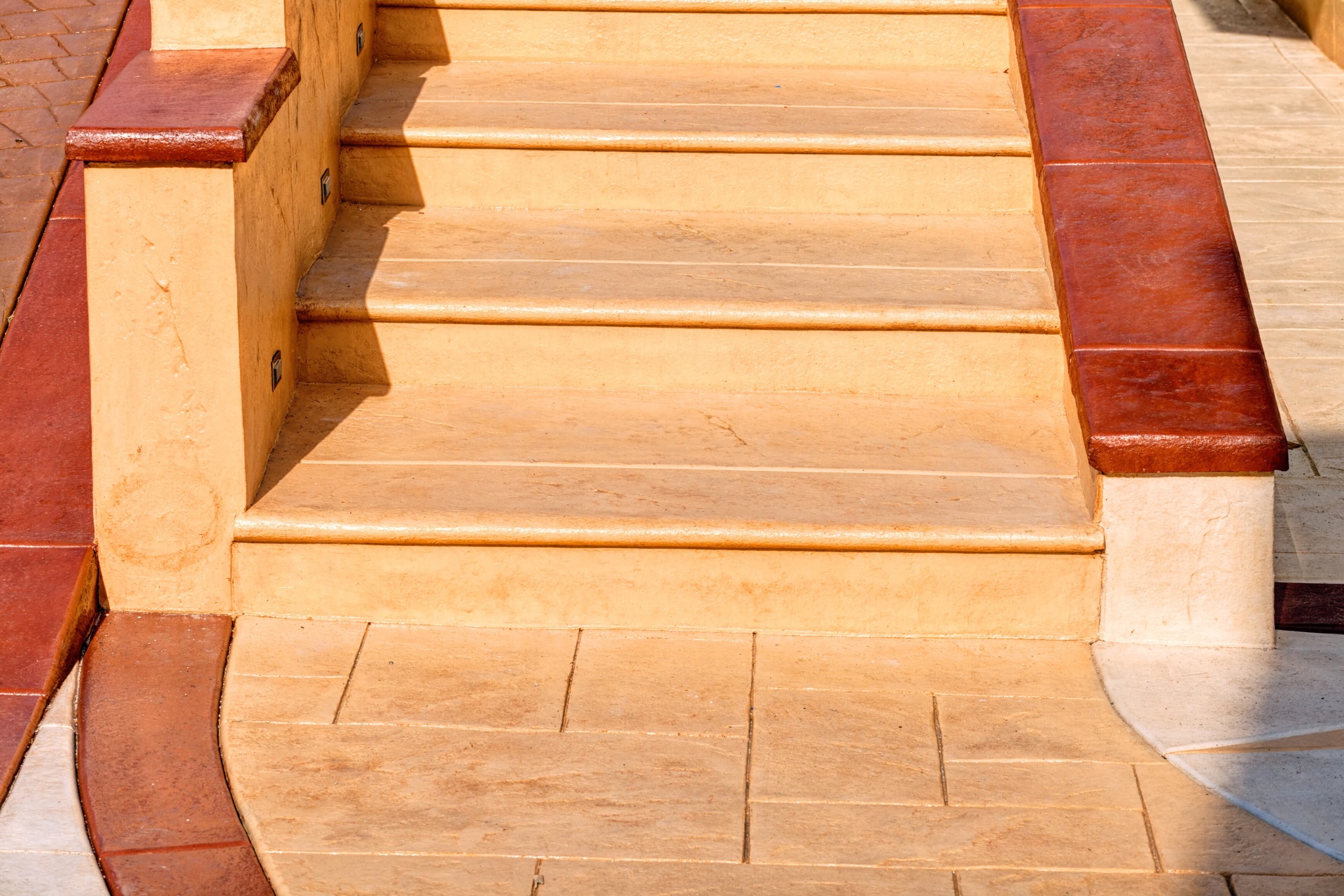You should seal your stamped concrete every 2 to 3 years, depending on its exposure to traffic and weather.
This frequency ensures protection from moisture, UV light, and chemicals, significantly extending its lifespan.
Regular sealing also enhances color, provides freeze-thaw resistance, and prevents stains and abrasions, maintaining your concrete’s structural integrity and curb appeal.
Ideal Sealing Frequency
To maintain its aesthetic appeal and durability, you should seal stamped concrete every 2 to 3 years, depending on exposure to traffic and weather conditions.
This frequency protects the surface from the deteriorating effects of moisture, ultraviolet light, and chemicals, which can all compromise its integrity over time.
Climate effects play a significant role in determining sealing frequency. In areas with harsh winters, frequent freeze-thaw cycles can cause unsealed or improperly sealed stamped concrete to crack and chip.
Similarly, regions with high humidity levels accelerate the growth of mold and mildew on the concrete surface, necessitating more frequent sealing to preserve its condition and appearance.
Additionally, installation errors, such as insufficient curing time before initial sealing or the application of an inappropriate sealant type, can significantly reduce the lifespan of stamped concrete.
These errors demand corrective measures, including possibly more frequent sealing intervals to mitigate ongoing damage.
Assess your stamped concrete’s exposure to these factors, and adjust the sealing frequency accordingly to ensure its longevity and maintain its visual appeal.
Benefits of Regular Sealing
Understanding the ideal sealing frequency for stamped concrete sets the stage for appreciating the many benefits regular sealing offers to both its aesthetic and structural integrity.
When you commit to a routine sealing schedule, you’re maintaining its appearance and actively contributing to its longevity and durability.
Here are three advantages of regular sealing:
Color Enhancement
One of the most noticeable benefits is the vivid color enhancement that sealing provides. The sealant acts as a barrier, protecting the pigments in the concrete from UV radiation and weathering, which can cause fading over time.
This means that the rich hues of your stamped concrete remain vibrant and striking, significantly boosting curb appeal.
Freeze-Thaw Resistance
Regular sealing imparts freeze-thaw resistance, safeguarding the structural integrity of your stamped concrete. This is critical in climates that experience severe winters.
Without adequate sealing, water can penetrate the concrete, freeze, expand, and cause cracking or spalling. A proper sealant prevents water ingress, thus mitigating the risk of freeze-thaw damage.
Protection Against Stains and Abrasions
A high-quality sealant forms a protective layer on the surface of the concrete, repelling water, oil, and other contaminants. This makes it easier to clean and maintain while also reducing wear from foot traffic and furniture.
Recognizing Wear and Damage
Before scheduling your next sealant application, learn to recognize the signs of wear and damage on your stamped concrete surfaces. Identifying these early can save you from extensive repairs and maintain the aesthetic appeal of your concrete.
One of the most apparent signs of wear is color fading. This occurs when the sealant, which acts as a protective barrier against UV rays, wears off, allowing sunlight to affect the pigments in your concrete directly.
If the vibrant hues of your stamped concrete look dull or uneven, it’s a clear indicator that the sealant is no longer effectively protecting it.
Additionally, the presence of small cracks or fissures is a telltale sign that your concrete requires attention. While stamped concrete is designed for durability, it’s not immune to the effects of thermal expansion, ground movement, or heavy loads.
These factors can contribute to the formation of cracks, compromising the structural integrity of your surface.
Regular sealing is imperative for crack prevention because it fills in minor crevices and prevents water from seeping in, which can exacerbate the damage.
Recognizing these signs of wear and acting promptly can ensure your stamped concrete remains in pristine condition for years to come.
Choosing the Right Sealant
Given the numerous options available on the market, how do you select the ideal sealant for your stamped concrete? The key lies in understanding the sealant types and application methods best suited for your specific project.
Here’s a structured approach to making your selection:
- Assess Sealant Types: There are primarily two types of sealants for stamped concrete: solvent-based and water-based. Solvent-based sealants are known for their durability and high gloss finish, enhancing the color of your stamped concrete. Water-based sealants offer an easier cleanup and are more environmentally friendly, though they may result in a less glossy finish.
- Consider Application Methods: The application method can significantly impact the final appearance and longevity of the sealant. Rollers, sprayers, and squeegees are the most common tools. Each has advantages. Sprayers often provide a more even coat, while rollers can be better for thicker, more viscous sealants.
- Evaluate Performance Requirements: Finally, consider the performance you need from the sealant, such as UV resistance, slip resistance, and ease of maintenance. Your choice should align with the specific demands of your environment and the level of foot traffic your stamped concrete will endure.
Maintenance Tips Between Sealings
To maintain your stamped concrete’s appearance and durability between sealings, regularly clean and inspect the surface for any signs of wear or damage.
Implementing effective cleaning practices plays a key role in preserving the integrity of your concrete.
- Start by removing debris with a broom or leaf blower.
- For more thorough cleaning, use a mild detergent and a pressure washer on a low setting to avoid etching the surface.
- Promptly clean spills, especially those that are acidic or oil-based, as they can penetrate the sealer and stain the concrete.
- During winter months, avoid using de-icing chemicals as these can cause surface damage and degrade the sealer.
- Opt for sand as a nondamaging alternative for traction.
- Minimize water accumulation on the concrete surface to prevent freeze-thaw cycles that can crack and deteriorate the stamped pattern.

